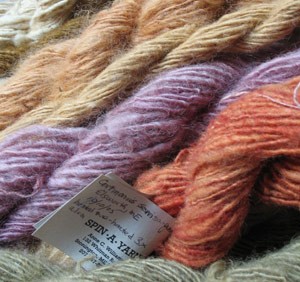
Each autumn, deciduous leaves transform the northern forest into a cheerful collage of oranges, reds, yellows, purples, and greens. Yet beneath this fleeting canopy grow longer-lasting and subtler sources of natural color: plants, mushrooms, and lichens that are used to dye wool and other fibers. Many of these dye species are not showy or immediately obvious, but they pack a pigment punch far beyond their outward appearance and have been used by residents of the northern forest for millennia.
Join us on a virtual field walk to learn about some of these dye species, the particular places where they grow, and some artisans in our region who use them to put a creative twist on “local color.” Bring a basket, a few grocery bags, comfortable shoes, and garden clippers. The map shown below will be our guide to this imaginary landscape.
We'll start our walk in the driveway of an old farmhouse, at the edge of a shady yard. The most potent dye plant in our region, the black walnut (Juglans nigra), would grow here if it grows anywhere. Though some parts of southern and western New York, Massachusetts, and Connecticut are in the black walnut’s native range, in northern New England, black walnuts don’t grow in the forest. They’re often planted in public places and near human habitation, and they’ll thrive in well-drained, fertile soils. With help from the lawnmower, their allelopathic properties keep the competition at bay.
Black walnut hulls and bark contain juglone, a natural compound that yields a rich, colorfast, brown dye. Though you can also make a dye with the nuts themselves, most artisans would be quick to tell you that you’d be better off eating them. The sticky green hulls give the strongest hue, though dried walnut hulls, even those that are decades old, still give up some color. Open-grown trees produce nuts at a younger age than those in forests, but the best production of nuts doesn’t occur until the tree is about 30 years old. From then on, though, a healthy tree will produce nuts for over a century. Don’t expect a haul every year; like many hard mast-producing species, black walnuts concentrate production in certain years, which are followed by nut-free years.
As your gaze shifts to the stone wall that runs along the edge of the driveway toward the stream, you might spot a few young offspring of this walnut growing among the rocks. These trees could have been inadvertently planted by squirrels who cached nuts in the rocky crevices of this human-built boundary. Squirrels also love butternuts (Juglans cinerea) and have planted many of them along stone walls, but butternut has done best in nutrient-rich forest soils.
Once a common tree in our forests, butternut is becoming rarer each year due to the fatal butternut canker, a fungus that girdles the tree. Like their black walnut cousins, these “white walnuts” have juglone in their tissues, and the nut hulls and bark have long been used for dyes. In fact, they were the primary dye for Confederate wool uniforms during the Civil War, giving those soldiers the nickname “butternuts.” Its distinctive bark – take the diamond-shaped furrows of white ash, and imagine they’ve been ironed and flattened – makes it recognizable even when dead. A healthy butternut producing nuts is a cause for celebration, a tree to visit and check on regularly. Leave some of the nuts for regeneration or sprout them yourself to plant later.
This stone wall leaves the driveway and separates an open field from a red pine plantation. Once a plowed field but then abandoned, it was planted with red pine through an erosion-control program of the Soil Conservation Service. Today, this red pine plantation is a grove of evenly spaced, virtually identical trees. A deep duff layer of pine needles makes it challenging for many plant species to grow. A few grasses, scattered lowbush blueberries, patches of moss, and seedlings of the hemlocks, red maples, and red oaks that will eventually replace the pines grow here, and not much else – for plants.
Yet places like this can be a gold mine for mushrooms, particularly those species that establish mycorrhizal relationships with plant roots. Plant roots physically interconnect with rootlike fungal structures called hyphae. The fungus secures nutrients and minerals from the soil and shares it with the plant; the plant produces sugar through photosynthesis and shares it with the fungus. Such symbiotic relationships between plants and fungi are common in nature and are especially important for many plant species that grow in acidic, sandy soil, such as blueberries and other members of the heath family. The fungus reproduces using spores, and sends up its fruiting bodies – mushrooms – when conditions are right for spores to be disseminated.
The surprise webcap mushroom (Cortinarius semisanguineus), prized for its red and pink pigments, is one such mycorrhizal fungus. When the mushrooms begin appearing in midsummer, pine plantations like this one are great places to find them, but you could also look along old woods roads or around forest gaps where light and understory conditions are similar. Surprise webcaps are rarely, if ever, found in deep shade, on wood, or within a foot of a tree trunk; instead, look for them on the ground, several feet away from trees, among drier mosses, needles, leaf litter, or lowbush blueberries. Sometimes they’re found near hardwoods, particularly red oak. If you find one, many more are probably growing nearby, so scan the ground carefully. Fiber artists who seek this small brown mushroom associate its presence with moderate light: not too little, not too much.
Surprise webcaps grow up to three inches in diameter, and the cap has a small knob in the center. True to its name, the browny-gold top shelters unexpected deep red gills, a surprise that can offer the thrill of a treasure hunt. Karen Wittshirk, a fiber artist from Huntington, Massachusetts, describes it this way: “All I can say is they glow. You’ll walk along and it’s got literally a glow to it. You think it’s just a brown mushroom, but once you’ve found it, you know it.” Some mushroom dyers separate the gilled caps and red stalk bases from the yellowish stalks to get a more intense red color, while others use the entire mushroom. Specimens can be used fresh or dried.
As you wander through the pine plantation, keep an eye out for another dye mushroom that infects coniferous trees: the dyer’s polypore (Phaeolus schweinitzii). Known for its yellow pigments, the dyer’s polypore is a non-mycorrhizal fungus that colonizes tree roots and emerges either from the ground or from decaying logs or stumps. As a root- and butt-rot fungus, its actively involved in decay (for more on this species, see “Velvet-top Fungus,” Northern Woodlands, Autumn 2005). Look for its large velvety rosettes at the bases of big, old conifers; dye gatherers in our region associate them with pine, hemlock, spruce, and tamarack trees. The rosettes, which can grow up to 18 inches across, are clam-shaped, with smaller “petals” emerging from the center. The tops feature concentric stripes of yellow, orange, and sometimes brown, and the spongy undersides have pores instead of gills. Follow the old stone wall along the pine plantation until you reach a stream, a watery trail that winds and twists its way along the lowest topographical reaches in the landscape.
As it moves through the shady forest, look for small mossy hollows right on its edge. Wittshirk describes such places, often under the silvery-green boughs of hemlocks, as “luminous.” Sometimes tree roots exposed by infrequent floods create these little depressions, which stay wet through most of the year and provide the perfect habitat for our third dye mushroom, the bloodred webcap mushroom (Cortinarius sanguineus). Closely related to the surprise webcap mushroom, this species is about the same size, though less common, more solitary, and more site-specific. Luckily, it can also be easier to spot, with its deep red cap, gills, and stalk. Its redder coloration produces a deeper red dye than that of the surprise webcap.
Look near these same sorts of cool, damp hollows, or between the mossy roots of trees, for goldthread (Coptis trifolia), a tiny yet powerful dye plant. A perennial with threelobed leaves, it shines on the forest floor, sprawling mat-like and sending up delicate starshaped flowers in late spring. It’s common in spruce-fir forests but also frequently appears under hemlocks or in acidic coniferous swamps and bogs. Goldthread and its close relatives encircle the northern hemisphere, spreading on golden rhizomes – creeping underground roots – through northern Japan, Siberia, the Aleutian Islands, the U.S.- Canada border region, and even Greenland’s southern coast. The gold comes from potent pigments in the roots, and simply boiling them in water will impart a golden dye to plant fibers and animal products, including wool, silk, and porcupine quills. The Micmacs, native to Quebec, Maine, and Atlantic Canada, as well as French settlers, used this dye extensively. Judy Dow, an Abenaki basketmaker from Essex, Vermont, uses it to dye black ash splints for making baskets. Out of all yellow-dyeing plants, she says that goldthread is the best. “It’s like schoolbus yellow.”
As you meander downstream toward drier, sunnier streambanks, especially those that meet abandoned fields or roadsides, scout for Canada goldenrod (Solidago Canadensis). This native plant flowers in late summer and early fall. Under the hand and eye of a skillful dyer, the brilliant yellow color of goldenrod flowers translates into beautifully hued dye for wool. Increasing the concentration of the dye with more plant material means deeper, more intense colors, while selecting only certain parts of the plant, such as the flower heads, will shift the colors. Susanne Grosjean, a weaver and rugmaker from Franklin, Maine, harvests all of the above-ground parts of goldenrod for her dyepot, though she notes that “the flowers will give you very clear yellows, the leaves will give greener, tanner yellows.”
A whole palette is possible with staghorn sumac (Rhus typhina), whose open groves of twisty trunks often line sunny streambanks, as well as ditches, field edges, or roadsides. This small tree can yield colors from beiges to yellows to reddish pinks to black. Sumac’s long, featherlike compound leaves and flame-shaped flower and fruit clusters make it unmistakable throughout much of the year, though the distinctive red clusters are only on female trees. The fuzzy, thin bark on its new growth gives it its name – the branches resemble the new antlers of a stag, or buck deer – and contains the tannins that make it a lightfast dyestuff.
Kate Smith, a fiber artist from Marshfield, Vermont, cuts small (less than half an inch thick) sumac branches before the berries come out in late summer, scrapes the bark off, and boils it to produce yellows and tans for dyeing wool. Judy Dow uses the entire twig to dye her basket materials yellow. Almost all parts of a sumac plant can be used for dyes – Native Americans across the country extracted pigments from the leaves, twigs, berries, and pith of woody trunks, as well as from the bark and roots. The Navajo and Hopi use another sumac species to make an intense black from boiled leaves and twigs that are processed with clay and piñon pine gum.
Cross the stream near where it enters a small wetland and head up into the hardwood forest on the other side. You’ll feel the slope growing steeper, studded with occasional rocks, until you reach the base of a small cliff. The dense glacial till on this hillside contrasts with the looser, sandy soil in the pine plantation. This hill is largely as the last glaciers left it, while the plantation area is composed of sediments deposited by water after the ice retreated and subsequently turned over by years of plowing. This hill was never plowed – it may have served as the hill farm’s woodlot or occasional woodland pasture.
Slopes below cliffs can contain unusual and interesting species of lichens, fascinating symbiotic organisms that join the physical structure of a fungus with the photosynthetic powers of algae or cyanobacteria. In the words of biologist Lynn Margulis, lichens “slowly turn solid rock inside out.” Frost heaving and acidic rain also decompose rock to form soil high in nutrients, which moves downslope via gravity and water. Roots of nutrient-hungry trees like butternut and American basswood catch these soil particles, known as colluvium, and thrive. Keep an eye out for these trees as we approach the cliff.
On the cliff itself, as well as on the larger boulders that have broken off from it, look for some common lichens that yield intense purple dyes: rock tripe (Umbilicaria Americana and U. mammulata), and toadskin lichen (Lasallia papulosa). They’re most common on rock faces with a 60- to 95-degree slope; any gentler and the rock will host mosses instead, but too much of an overhang won’t let them get established. Despite their drab gray, brown, or black coloring, these lichens and others have yielded valuable and brilliant dyes throughout history.
The ancient Phoenicians used lichens to dye cloth purple – the color of royalty – as early as 3000 BC. Anne Williams, of Deer Isle, Maine, keeps a perennial lichen dyebath going in her garage, adds new material once in awhile, and soaks wool for up to four months to get the most intense purples.
Demand for Scottish lichens in the Industrial Revolution caused many species to go locally extinct from overharvesting. Today, dyers like Williams use the flat, leaflike part of these lichens, called the thallus. It’s best to harvest material that is already detached from the rock on which it grew. If you harvest lichen from cliffs and boulders, spot-harvest over a wide area rather than clearing an entire section. That way, the remaining thalluses can grow to fill in the gaps you leave. Use clippers so you only take the thallus, and leave the holdfast stalk, or rhizine, attached to the rock.
We’ve reached the end of our dye expedition. Before you head down to start coaxing colors out of the materials you’ve gathered today, look up and take in the colorful vista around you. From this cliff, you can look across ridges, pastures, gullies, and river valleys. In each place, organisms grow that give us heat, food, shelter, medicine, art, and pleasure. Through training your eye and knowing what to look for, you’ll find vibrant riches in the landscape in every season.
For Further Reference and Directions for Dyeing
Cardon, Dominique. Natural dyes: Sources, tradition, technology, and science. London: Archetype Press, 2007. An encyclopedic reference for serious dyers.
Diamond, Allaire. Art from the forest: A guide for landowners. Vermont Land Trust, 2009. Diamond, Allaire.
Rice, Miriam, and Dorothy Beebee. Mushrooms for dyes, paper, pigments, and Myco-stix. Forestville, CA: Mushrooms for Color Press, 2007.


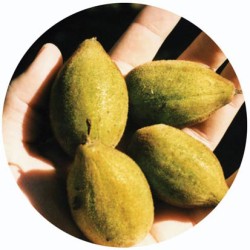
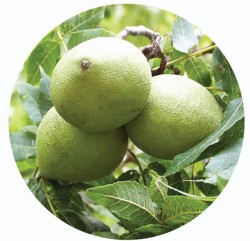
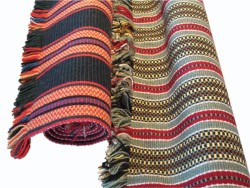
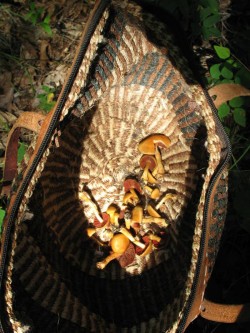
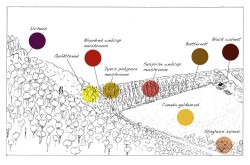
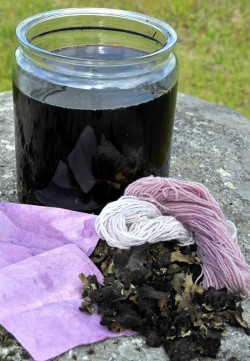
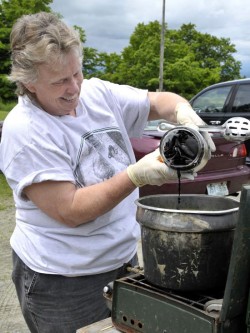
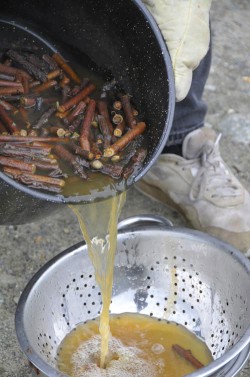
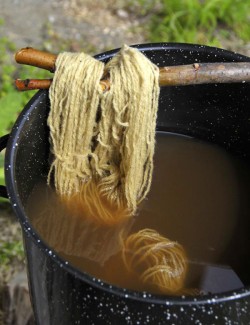
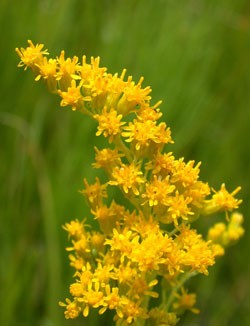
Discussion *